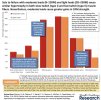It’s not preference.
Weekly volume is the most important factor.
Anywhere for 3-20 reps will build muscle with 5-15 being the most optimal.
Although yeah, just follow a bro split off Google….
You come off like an arrogant prick, which right off the bat makes you seem like someone who wants to be believed, but has no clue wtf they are talking about; people like you are cancers to forums, and I will always slap your type down, because you deserve it.
So let's begin:
First, you retardedly admit 3-20 reps will build muscle, (quite a big range one can choose from:
preference), but then you arbitrarily give another rep-range with 5 to 15 (literally 10 rep range), claiming it is "optimal" because I guess the body just arbitrarily responds to mathematical abstract numbers, rather than getting close to or to failure. You see, studies have shown three reps shy of failure has almost the
same effects as to failure; this is where RIR-type training comes in. I personally don't like training with RIR at all; I always go to technical failure, but many people have created programs and use this method as a way to track progressive overload, with a shit ton of variance in their rep ranges, all the way up to 30 reps if they choose.
Then you indirectly shit on bro splits, as if they don't work and the 90's never happened lol. Most pros use bro splits, and the reason is because as they become stronger, they can move more weight, their bodies adapts much more to training, and they literally need to destroy the muscle one at a time. There has been a return to PPL and other twice-a-week splits by
some people (frequency), but their volume is reduce per session so they can make their split work. However, if someone doesn't like to train that way, they will not stick to their program, especially if it doesn't fit their schedule or lifestyle. At the end, it makes no difference: studies have shown that if volume is equated, literally
everything works so long as you work hard, are consistent, and bring your muscles close to or to failure.
You see, if actually knew what you were talking about, getting close to or to failure recruits every fiber type; muscles fire in a sequence. What matters is
mechanical tension, which can be achieved in many ways, with various techniques, and
intensity; however, you need a certain amount of your 1RM to get the proper tension, which is why you can't pick up a 5lb dumbbell and do 1000 reps, thinking you'll get jacked. So anywhere from your 30% to 70% IRM is what studies have shown will induce hypertrophy; the issue with the former is, can one fight through the lactic acid and burn? Probably not, so it is actually much easier to train with a bit heavier load to reach failure faster: imagine trying to do 30 rep squats vs 10; your lung will probably give out before your legs. But this doesn't mean one is better than the other; in fact, each have their pros and cons, so you pulled this "optimal range" out of your ass. Tom Platz would do retarded high rep sets and his quads are the most insane in bodybuilding history; I guess he didn't train optimal enough lol.
You can do as much volume as you want, if it is not creating
mechanical tension, you're not going to grow. If volume was the main factor, every retard in the gym would keep growing just by adding more sets, but they aren't. Moreover, low-volume methods disprove volume as the "most important factor." Take Yates and others like him for example who trained with low volume and low frequency but super-high intensity, going BEYOND failure which isn't even necessary, but because he did, forced him to spend more time in recovery, and needing way less volume. If volume was the "most important factor," Yates should have never grown at all, nor won Mr. O several times.
So no, volume is not the most important factor, so kindly shut the fuck up and stop talking down to people.


